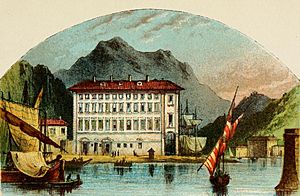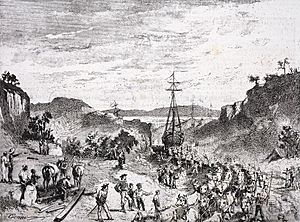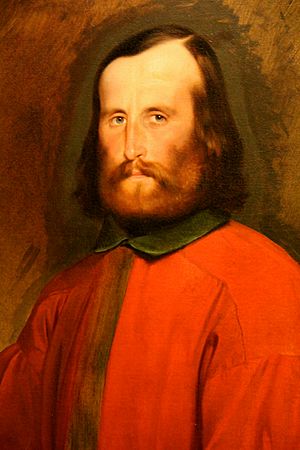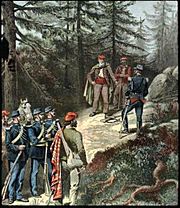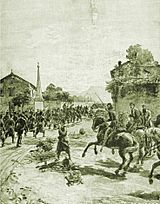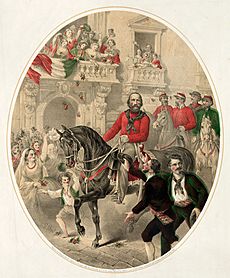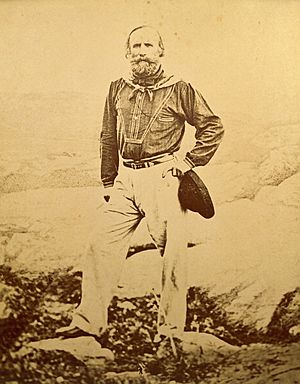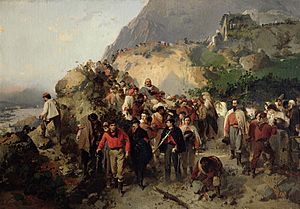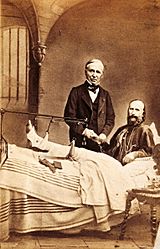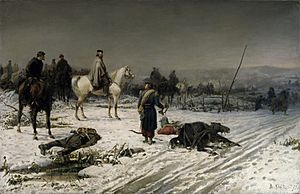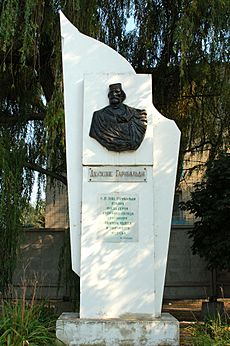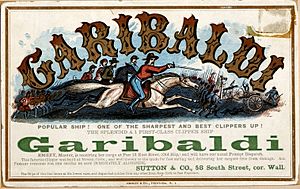Giuseppe Garibaldi facts for kids
Quick facts for kids
Giuseppe Garibaldi
|
|
|---|---|
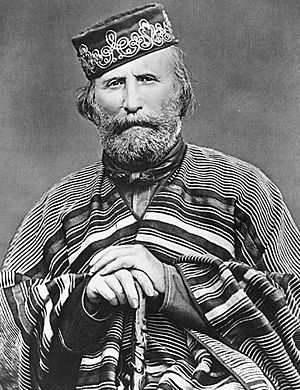
Garibaldi in 1866
|
|
|
|
| In office 18 February 1861 – 2 June 1882 |
|
| Dictator of Sicily | |
| In office 17 May 1860 – 4 November 1860 |
|
| Minister of War of the Roman Republic | |
| In office 9 February 1849 – 25 April 1849 |
|
| Preceded by | Position established |
| Succeeded by | Position abolished |
| Personal details | |
| Born |
Giuseppe Maria Garibaldi
4 July 1807 Nice, French Empire |
| Died | 2 June 1882 (aged 74) Caprera, Kingdom of Italy |
| Nationality | Italian, Peruvian (1851–1882) |
| Political party |
|
| Spouses |
Anita Garibaldi
(m. 1842)Giuseppina Raimondi
(m. 1860)Francesca Armosino
(m. 1880) |
| Children | Menotti, Ricciotti, and 6 others |
| Signature | |
| Military service | |
| Allegiance |
List of allegiances
|
| Branch |
|
| Service years | 1835–1871 |
| Rank | General |
| Commands |
|
| Wars | Ragamuffin War
Uruguayan Civil War
1st War of Independence
Battle of Novara Siege of Rome 2nd War of Independence Battle of Varese Expedition of the Thousand Battle of Calatafimi Battle of Milazzo Battle of Volturnus Battle of Aspromonte 3rd War of Independence Battle of Bezzecca Invasion of Trentino Battle of Mentana Battles of Dijon
|
Giuseppe Garibaldi (4 July 1807 – 2 June 1882) was an Italian general and a great patriot. He played a huge role in uniting Italy and creating the Kingdom of Italy. Many people consider him one of the best generals in modern history. He is also known as the "Hero of the Two Worlds" because he fought in wars in both South America and Europe.
Garibaldi believed in Italian nationalism and wanted a united Italy. He was a follower of Giuseppe Mazzini and the Young Italy movement, which aimed for a democratic republic. Later, he worked with Camillo Benso, Count of Cavour and the Kingdom of Sardinia to achieve independence. He put his dream of a republic aside for a while to help unify Italy.
After being involved in an uprising, Garibaldi had to leave Italy. He spent 14 years in South America, where he learned about guerrilla warfare. He joined rebels in Brazil and Uruguay, even leading an Italian force known as the Redshirts. He is still celebrated in Uruguay for his help.
In 1848, Garibaldi returned to Italy. He led military campaigns that helped unite the country. He became a general and even a minister of war for the Roman Republic. In 1859, he led his Hunters of the Alps to victory in Lombardy. The next year, he led the famous Expedition of the Thousand, which helped annex Sicily and Southern Italy. This led to the creation of a unified Kingdom of Italy in 1861. His last military campaign was during the Franco-Prussian War.
Garibaldi became a symbol for national independence and freedom around the world. Many important people admired him, including Abraham Lincoln and Charles Dickens. He is often remembered for the red shirts his volunteers wore instead of uniforms.
Contents
- Garibaldi's Early Life
- Adventures in South America
- Becoming a Freemason
- Return to Italy and First War
- Travels and Return Home
- Second Italian War of Independence
- The Campaign of 1860: Uniting Italy
- After Unification
- Efforts to Capture Rome
- Final Fight with Austria
- Later Years and Death
- Garibaldi's Legacy
- How Garibaldi is Remembered
- Cultural Depictions
- Family Tree
- Images for kids
- See also
Garibaldi's Early Life
Giuseppe Garibaldi was born on 4 July 1807 in Nice. At that time, Nice was part of the French Empire. His family was involved in sea trade, which led him to a life on the ocean. By 1832, he became a captain in the merchant navy.
In 1833, he met Giovanni Battista Cuneo, a member of the secret Young Italy movement. This group wanted to unite Italy as a free republic. Garibaldi joined them and promised to fight for his homeland's freedom from Austrian rule. He later met Giuseppe Mazzini, the leader of Young Italy.
In 1834, Garibaldi took part in an uprising that failed. He had to flee Italy and went to Marseille.
Adventures in South America
Garibaldi first sailed to Tunisia, then made his way to Brazil. There, he joined rebels called the Ragamuffins in the Ragamuffin War of 1835. They were fighting for the independence of the Riograndense Republic.
During this war, he met Ana Maria de Jesus Ribeiro da Silva, known as Anita. She joined him on his ship and fought alongside him. In 1841, Garibaldi and Anita moved to Montevideo, Uruguay. They got married there and had four children. Anita taught Giuseppe about the gaucho culture of the region. Around this time, he started wearing his famous red shirt, poncho, and sombrero.
In 1842, Garibaldi took charge of the Uruguayan fleet. He also created an Italian Legion of soldiers, who became known as the Redshirts. Many Italians lived in Montevideo, making it possible to recruit these soldiers.
Garibaldi's forces fought in the Uruguayan Civil War. They defended Montevideo against enemy troops. He used clever guerrilla tactics, fighting from the water and land. He won important battles like the Battle of Cerro and the Battle of San Antonio del Santo in 1846.
Becoming a Freemason
Garibaldi joined the Freemasons while he was in exile. This group offered help to political refugees. He became an active Freemason and saw it as a way to connect people who wanted progress and freedom. He believed it united people as brothers around the world. Garibaldi was later chosen as the Grand Master of the Grand Orient of Italy.
Return to Italy and First War
In 1848, Garibaldi returned to Italy during a time of revolution. He offered his help to Charles Albert of Sardinia, but was turned away. So, he went to Milan, which was rebelling against Austrian rule. In the First Italian War of Independence, Garibaldi led his legion to small victories.
After a major defeat for the Italian forces in 1849, Garibaldi went to Rome. He helped defend the Roman Republic against French forces. On 30 April 1849, his army defeated a larger French army. However, more French soldiers arrived, and Rome was besieged. Garibaldi and his troops had to leave Rome. His wife, Anita, who was pregnant, sadly died during this retreat.
Travels and Return Home
After leaving Italy again, Garibaldi traveled a lot. He went to Tangier, then to New York in the United States. He even worked in a candle factory on Staten Island. Later, he sailed across the Pacific Ocean, visiting places like China and Australia.
In 1854, Garibaldi returned to Italy. He used money he inherited to buy half of the island of Caprera, where he started farming.
Second Italian War of Independence
In 1859, the Second Italian War of Independence began. Italy allied with France against Austria. Garibaldi was made a major general and formed a volunteer group called the Hunters of the Alps. He decided that only the Sardinian monarchy could truly unite Italy. He and his volunteers won battles against the Austrians.
Garibaldi was upset when his hometown of Nice was given to France in exchange for military help. He strongly spoke out against this decision.
The Campaign of 1860: Uniting Italy
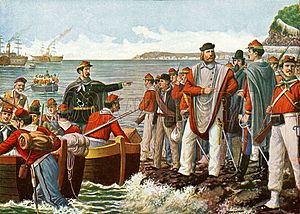
In April 1860, uprisings in Sicily gave Garibaldi a new chance. He gathered about a thousand volunteers, known as i Mille (the Thousand) or the Redshirts. They sailed from Genoa and landed in Sicily on 11 May.
Garibaldi's small army, joined by local rebels, won a key victory at Calatafimi on 15 May. He used a surprising tactic of charging uphill with bayonets. This battle showed his strength on the island. He famously said, "Here we either make Italy, or we die."
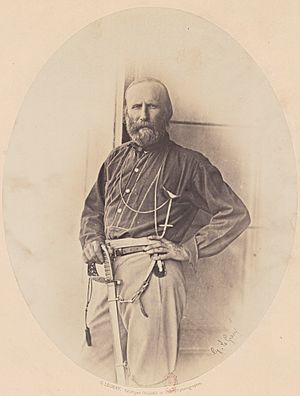
The next day, he declared himself the ruler of Sicily in the name of Victor Emmanuel II of Italy. He attacked Palermo, the capital, and many people in the city supported him. After a siege, the royal troops left the city. Garibaldi's volunteers were mostly students and skilled workers, not peasants. The local peasants supported him because they disliked their landlords and the government.
After conquering Palermo, Garibaldi became world-famous. He then marched towards Messina, winning another tough battle at Milazzo. By the end of July, he controlled most of Sicily.
He then crossed to the mainland and marched north. People cheered him as he went, and he entered Naples on 7 September. His army of 24,000 fought a large battle at Volturno, which was decided when the Piedmontese Army arrived.
Garibaldi wanted to march on Rome, but the Piedmontese government didn't want to risk war with France, who protected the Pope. Garibaldi decided to give all his conquered lands in the south to the Piedmontese king. He then went back to his island home, Caprera. This meeting between Garibaldi and Victor Emmanuel II is a very important moment in Italian history.
After Unification
Garibaldi didn't like the Sardinian Prime Minister, Camillo Benso, Count of Cavour, partly because Cavour had given Nice to France. However, he supported King Victor Emmanuel II. In their famous meeting in 1860, Garibaldi greeted him as the King of Italy. Garibaldi rode into Naples with the king, then returned to Caprera, refusing any rewards for his service.
During the American Civil War (1861), Garibaldi was very popular. He was even offered a high rank in the U.S. Army, but he didn't join. He supported the Union cause, especially after the Emancipation Proclamation was issued. He wrote to President Lincoln, calling him "the great emancipator."
In 1861, Garibaldi created the International Legion, bringing together volunteers from different countries. Their goal was to free Italy completely and help other nations gain independence.
Efforts to Capture Rome
Garibaldi strongly opposed the Pope's rule over Rome. Many Catholics around the world were worried about his plans. The French Emperor Napoléon III had French soldiers in Rome to protect the Pope. King Victor Emmanuel didn't want to attack Rome because of international problems.

In 1862, Garibaldi sailed to Palermo to gather volunteers to march on Rome. He arrived with about two thousand men, but the king's soldiers stopped him from crossing to the mainland. He then sailed to Catania and marched into the mountains.
The Italian government sent its army to stop Garibaldi. On 28 August, the two forces met. Garibaldi told his men not to fire on fellow Italians. He was wounded in the foot and taken prisoner. He was held in a kind of honorable prison and later released, returning to Caprera.
In 1864, Garibaldi visited London and was greeted with great excitement. He met the British Prime Minister and other revolutionaries.
Final Fight with Austria
Garibaldi fought again in 1866, this time with the Italian government's full support. Italy allied with Prussia against Austria to gain Venetia. Garibaldi led his Hunters of the Alps, now 40,000 strong, into Trentino. He defeated the Austrians at Bezzecca.
The war ended with Austria giving Venetia to Italy. Garibaldi was ordered to stop his advance. He famously replied with a short telegram: Obbedisco! ("I obey!").
After the war, Garibaldi continued to push for Rome to become Italy's capital. In 1867, he marched on the city again. But the Pope's army, supported by French soldiers, defeated his volunteers. Garibaldi was wounded and had to retreat. The Italian government imprisoned him again briefly before he returned to Caprera.
In 1870, the Franco-Prussian War broke out. After France's defeat, Garibaldi supported the new French Republic. He went to France and led an army of volunteers called the Army of the Vosges. After the war, he was elected to the French National Assembly before returning to Caprera.
Later Years and Death
Garibaldi believed in a kind of ethical socialism and saw the fight for freedom as a global effort. He supported the Paris Commune in 1871 and believed in the brotherhood of all people. He saw the International Workingmen's Association as a way to extend humanitarian ideals.
Even though he was elected to the Italian parliament, Garibaldi spent most of his later years on Caprera. He supported projects to improve the land in southern Lazio. In 1879, he founded the League of Democracy, which supported universal voting rights, women's rights, and public works.
Giuseppe Garibaldi died on 2 June 1882, at almost 75 years old. He had asked for a simple funeral and cremation, but his wishes were not fully followed. He was buried on his farm on the island of Caprera with his last wife and some of his children.
Garibaldi's Legacy

Garibaldi's popularity and military skills helped make the unification of Italy possible. He became a global example of a revolutionary leader in the mid-19th century. After freeing southern Italy, he chose to put his dream of a republic aside for the sake of unity. His adventures became legendary, and he was seen as a hero around the world.
Garibaldi was against the Pope's political power. His personal religious beliefs are not entirely clear. He once wrote that "Man created God," but also said he loved and respected the religion of Christ.
Many people admired Garibaldi. Historian A. J. P. Taylor called him "the only wholly admirable figure in modern history." Along with Giuseppe Mazzini, Garibaldi supported the idea of a European federation.
How Garibaldi is Remembered
- Five ships of the Italian Navy have been named after him.
- Statues of Garibaldi are found in many Italian squares and around the world.
- The 39th New York Volunteer Infantry Regiment in the American Civil War was named Garibaldi Guard.
- In 1865, the English football team Nottingham Forest chose their red home colors from the uniform worn by Garibaldi's men.
- The Giuseppe Garibaldi Trophy is a rugby union award given to the winner of the annual match between France and Italy.
- The Garibaldi biscuit and a type of beard were named after him.
- A bright red-orange fish, the Garibaldi, was named after his red shirts.
- Many places around the world are named after him, including towns, mountains, and parks.
Cultural Depictions
Garibaldi appears as a character in several books and movies.
- In movies, he has been played by actors like Raf Vallone and Renzo Ricci.
- The American TV series Dick Powell's Zane Grey Theatre had an episode called "Guns for Garibaldi" in 1960.
- In the video game Knights of the Round, the final boss is named "Garibaldi."
Family Tree
| Giuseppe Garibaldi | Ana Maria de Jesus Ribeiro da Silva | ||||||||||||||||||||||||||||||||||||||||||||||||||||||||||||||
| Domenico Menotti Garibaldi | Rosa "Rosita" Garibaldi | Teresa "Teresita" Garibaldi | Ricciotti Garibaldi | Harriet Constance Hopcraft | |||||||||||||||||||||||||||||||||||||||||||||||||||||||||||
| Peppino Garibaldi | Costante Garibaldi | Anita Italia Garibaldi | Ezio Garibaldi | Bruno Garibaldi | Ricciotti Garibaldi Jr. | Menotti Garibaldi Jr. | Sante Garibaldi | ||||||||||||||||||||||||||||||||||||||||||||||||||||||||
Images for kids
-
Garibaldi's poncho and red shirt at the Museum of the Risorgimento, Milan
See also
 In Spanish: Giuseppe Garibaldi para niños
In Spanish: Giuseppe Garibaldi para niños
- Italian irredentism
- Italian unification
- Giuseppe Mazzini


